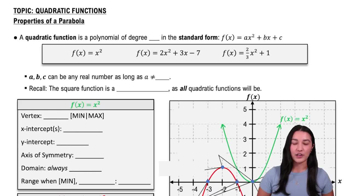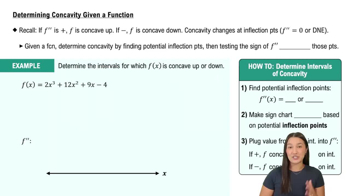Does ƒ(x) = (x⁶/2) + (5x⁴/4) - 15x² have any inflection points? If so, identify them.
Table of contents
- 0. Functions7h 54m
- Introduction to Functions16m
- Piecewise Functions10m
- Properties of Functions9m
- Common Functions1h 8m
- Transformations5m
- Combining Functions27m
- Exponent rules32m
- Exponential Functions28m
- Logarithmic Functions24m
- Properties of Logarithms36m
- Exponential & Logarithmic Equations35m
- Introduction to Trigonometric Functions38m
- Graphs of Trigonometric Functions44m
- Trigonometric Identities47m
- Inverse Trigonometric Functions48m
- 1. Limits and Continuity2h 2m
- 2. Intro to Derivatives1h 33m
- 3. Techniques of Differentiation3h 18m
- 4. Applications of Derivatives2h 38m
- 5. Graphical Applications of Derivatives6h 2m
- 6. Derivatives of Inverse, Exponential, & Logarithmic Functions2h 37m
- 7. Antiderivatives & Indefinite Integrals1h 26m
- 8. Definite Integrals4h 44m
- 9. Graphical Applications of Integrals2h 27m
- 10. Physics Applications of Integrals 3h 16m
- 11. Integrals of Inverse, Exponential, & Logarithmic Functions2h 31m
- 12. Techniques of Integration7h 41m
- 13. Intro to Differential Equations2h 55m
- 14. Sequences & Series5h 36m
- 15. Power Series2h 19m
- 16. Parametric Equations & Polar Coordinates7h 58m
5. Graphical Applications of Derivatives
Concavity
Problem 4.4.114b
Textbook Question
114. Parabolas
b. When is the parabola concave up? Concave down?
 Verified step by step guidance
Verified step by step guidance1
To determine when a parabola is concave up or concave down, we need to look at the second derivative of its equation. A parabola is typically given by the quadratic function \( f(x) = ax^2 + bx + c \).
The second derivative of the function \( f(x) = ax^2 + bx + c \) is \( f''(x) = 2a \). This is a constant value, meaning it does not depend on \( x \).
A parabola is concave up when the second derivative is positive. Therefore, if \( 2a > 0 \), the parabola is concave up. This simplifies to \( a > 0 \).
Conversely, a parabola is concave down when the second derivative is negative. Therefore, if \( 2a < 0 \), the parabola is concave down. This simplifies to \( a < 0 \).
In summary, the concavity of a parabola is determined by the sign of the coefficient \( a \) in the quadratic function. If \( a > 0 \), the parabola is concave up, and if \( a < 0 \), it is concave down.
 Verified video answer for a similar problem:
Verified video answer for a similar problem:This video solution was recommended by our tutors as helpful for the problem above
Video duration:
1mPlay a video:
Was this helpful?
Key Concepts
Here are the essential concepts you must grasp in order to answer the question correctly.
Parabola
A parabola is a U-shaped curve that can open upwards or downwards, defined by a quadratic function of the form y = ax^2 + bx + c. The direction in which the parabola opens is determined by the sign of the coefficient 'a'. If 'a' is positive, the parabola opens upwards; if 'a' is negative, it opens downwards.
Recommended video:

Properties of Parabolas
Concavity
Concavity refers to the direction in which a curve bends. A function is concave up if it bends upwards like a cup, and concave down if it bends downwards like a cap. For a parabola, concavity is determined by the sign of the leading coefficient 'a' in the quadratic equation: positive 'a' indicates concave up, while negative 'a' indicates concave down.
Recommended video:

Determining Concavity Given a Function
Second Derivative Test
The second derivative test is used to determine the concavity of a function. For a quadratic function y = ax^2 + bx + c, the second derivative is a constant, 2a. If 2a > 0, the function is concave up, and if 2a < 0, it is concave down. This test helps in identifying the nature of the parabola's curvature.
Recommended video:

The Second Derivative Test: Finding Local Extrema

 6:38m
6:38mWatch next
Master Determining Concavity from the Graph of f with a bite sized video explanation from Patrick
Start learningRelated Videos
Related Practice
Textbook Question
